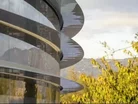New sustainable Apple building to be built in Cupertino, California

Apple Park in Cupertino will be situated on 175 acres of rolling parkland and will be one of the most energy-efficient buildings in the world. The process of moving more than 12,000 people will take over six months, and construction of the buildings and parklands is scheduled to continue through the summer.
Envisioned by Steve Jobs as a center for creativity and collaboration, Apple Park is transforming miles of asphalt sprawl into a haven of green space in the heart of the Santa Clara Valley. The campus’ ring-shaped, 2.8 million-square-foot main building is clad entirely in the world’s largest panels of curved glass.
Steve Jobs would have turned 62 on February 24. To honour his memory and his enduring influence on Apple and the world, the theater at Apple Park will be named the Steve Jobs Theater. Opening later this year, the entrance to the 1,000-seat auditorium is a 20-foot-tall glass cylinder, 165 feet in diameter, supporting a metallic carbon-fiber roof. The Steve Jobs Theater is situated atop a hill — one of the highest points within Apple Park — overlooking meadows and the main building.
“Steve’s vision for Apple stretched far beyond his time with us. He intended Apple Park to be the home of innovation for generations to come,” said Tim Cook, Apple’s CEO. “The workspaces and parklands are designed to inspire our team as well as benefit the environment. We’ve achieved one of the most energy-efficient buildings in the world and the campus will run entirely on renewable energy.”
“Steve was exhilarated, and inspired, by the California landscape, by its light and its expansiveness. It was his favorite setting for thought. Apple Park captures his spirit uncannily well,” said Laurene Powell Jobs. “He would have flourished, as the people of Apple surely will, on this luminously designed campus.”
“Steve invested so much of his energy creating and supporting vital, creative environments. We have approached the design, engineering and making of our new campus with the same enthusiasm and design principles that characterize our products,” said Jony Ive, Apple’s chief design officer.
“Connecting extraordinarily advanced buildings with rolling parkland creates a wonderfully open environment for people to create, collaborate and work together. We have been extremely fortunate to be able to work closely, over many years, with the remarkable architectural practice Foster + Partners.”
Apple Park will also include a visitors center with an Apple Store and cafe open to the public, a 100,000-square-foot fitness center for Apple employees, secure research and development facilities and the Steve Jobs Theater. The parklands offer two miles of walking and running paths for employees, plus an orchard, meadow and pond within the ring’s interior grounds.
Designed in collaboration with Foster + Partners, Apple Park replaces 5 million-square-feet of asphalt and concrete with grassy fields and over 9,000 native and drought-resistant trees, and is powered by 100 percent renewable energy. With 17 megawatts of rooftop solar, Apple Park will run one of the largest on-site solar energy installations in the world. It is also the site of the world’s largest naturally ventilated building, projected to require no heating or air conditioning for nine months of the year.



